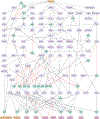Mechanical regulation of gene expression in cardiac myocytes and fibroblasts
- PMID: 30683889
- PMCID: PMC6525041
- DOI: 10.1038/s41569-019-0155-8
Mechanical regulation of gene expression in cardiac myocytes and fibroblasts
Abstract
The intact heart undergoes complex and multiscale remodelling processes in response to altered mechanical cues. Remodelling of the myocardium is regulated by a combination of myocyte and non-myocyte responses to mechanosensitive pathways, which can alter gene expression and therefore function in these cells. Cellular mechanotransduction and its downstream effects on gene expression are initially compensatory mechanisms during adaptations to the altered mechanical environment, but under prolonged and abnormal loading conditions, they can become maladaptive, leading to impaired function and cardiac pathologies. In this Review, we summarize mechanoregulated pathways in cardiac myocytes and fibroblasts that lead to altered gene expression and cell remodelling under physiological and pathophysiological conditions. Developments in systems modelling of the networks that regulate gene expression in response to mechanical stimuli should improve integrative understanding of their roles in vivo and help to discover new combinations of drugs and device therapies targeting mechanosignalling in heart disease.
Conflict of interest statement
Competing interests
J.J.S., P.M.T. and K.S.B. declare no competing interests.
Figures


References
-
- Mann DL Left ventricular size and shape: determinants of mechanical signal transduction pathways. Heart Fail. Rev 10, 95–100 (2005). - PubMed
-
- Swynghedauw B Darwinian evolution and cardiovascular remodeling. Heart Fail. Rev 21, 795–802 (2016). - PubMed
-
- Chiquet M, Gelman L, Lutz R & Maier S From mechanotransduction to extracellular matrix gene expression in fibroblasts. Biochim. Biophys. Acta 1793, 911–920 (2009). - PubMed
-
- Barry SP, Davidson SM & Townsend PA Molecular regulation of cardiac hypertrophy. Int. J. Biochem. Cell Biol 40, 2023–2039 (2008). - PubMed
Publication types
MeSH terms
Grants and funding
LinkOut - more resources
Full Text Sources
Medical

